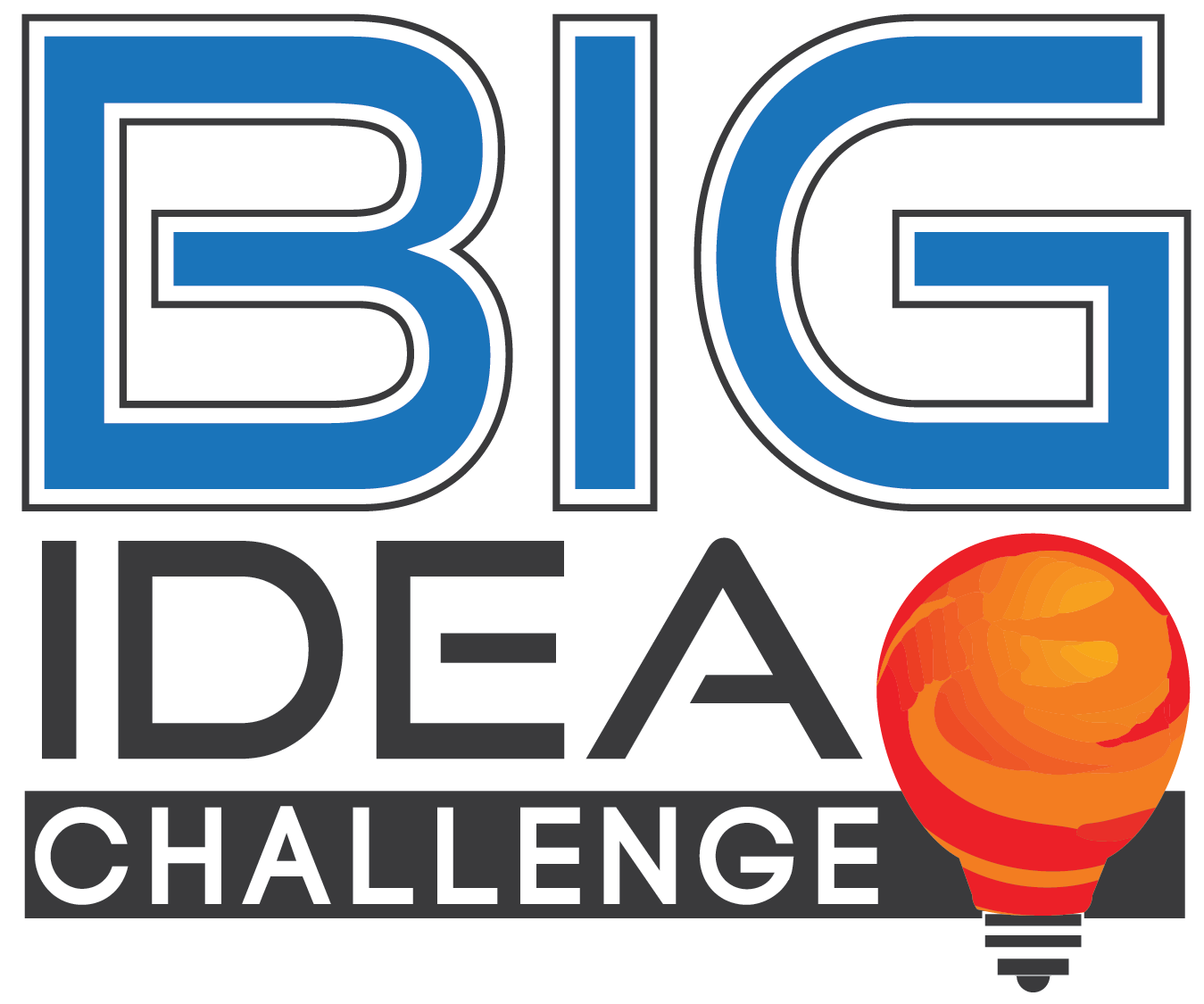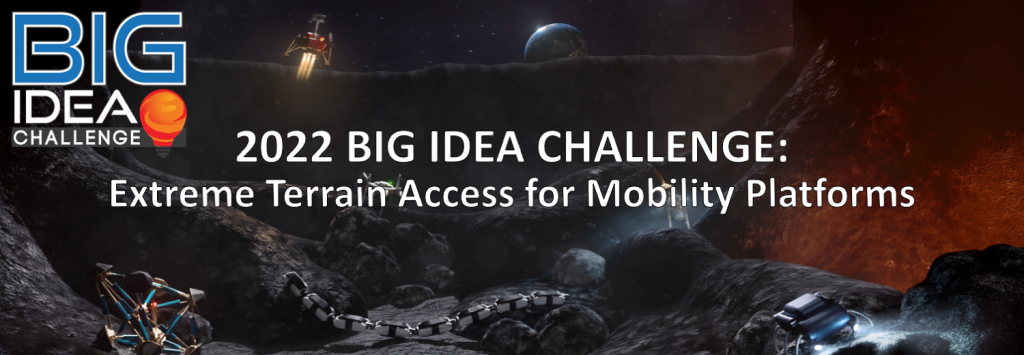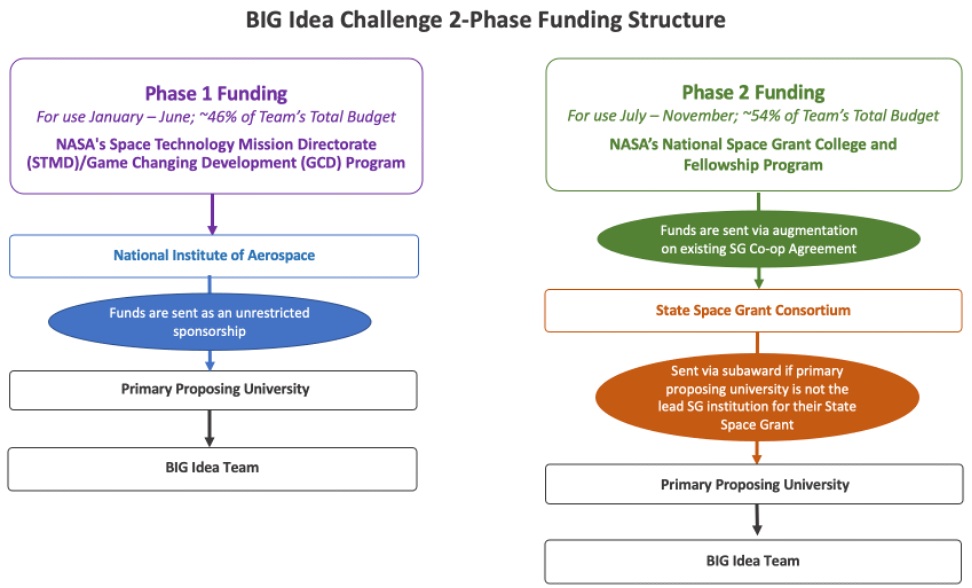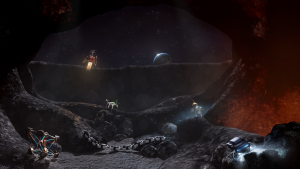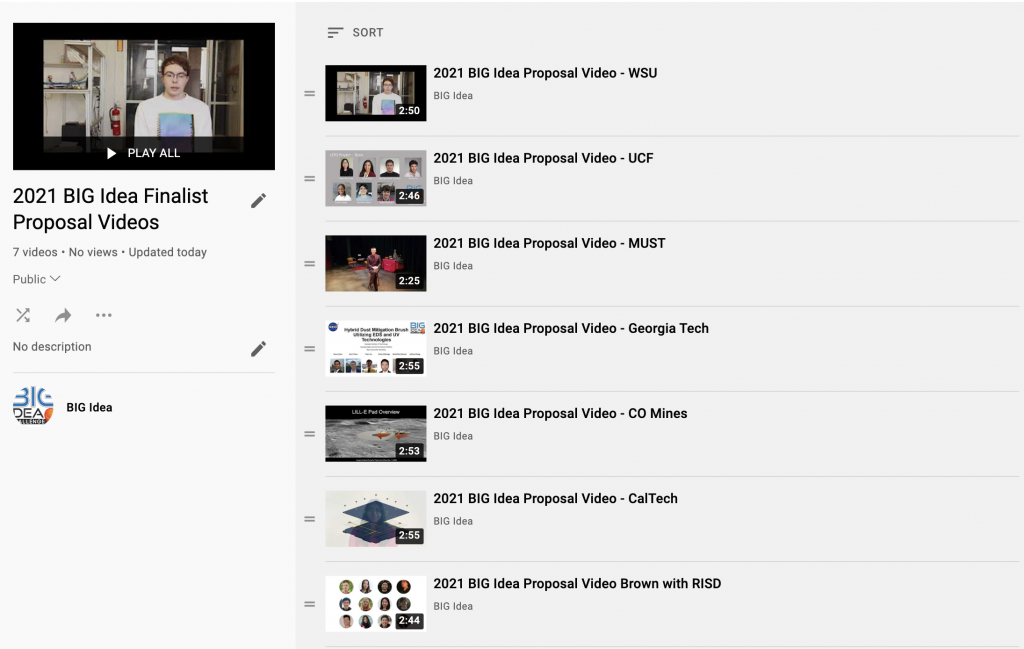THE 2022 BIG IDEA CHALLENGE:
EXTREME TERRAIN ACCESS FOR MOBILITY PLATFORMS
View Full 2022 Challenge Guidelines Read the 2022 NASA Feature Story
The 2022 BIG Idea Challenge provides undergraduate and graduate students the opportunity to design, develop, and demonstrate robotic systems with alternative rover locomotion modalities for use in off-world extreme lunar terrain applications. This competition is intended to be an open innovation challenge with minimal constraints so that proposing teams can genuinely create and develop out-of-the-box solutions. Teams are invited to submit proposals for robots with new mobility solutions in operating scenarios that require access to extreme terrain categories, such as, but not limited to:
-
⇒ Fluffy/high-porosity regolith expected at the lunar poles
⇒ Steep, rugged slopes (state of the art for a wheeled rover is ~30 degrees)
⇒ Uneven terrain with possible ice content at the bottom of deep-shadowed craters
⇒ Subterranean features, such as caves, lava tubes, and pits
Through this challenge, NASA seeks innovative ideas from the academic community for a wide range of alternative rover locomotion modalities to either enhance or replace traditional wheeled mobility systems that can expand our access to extreme terrain on the Moon and (later) on Mars. Teams should keep in mind that although the lunar surface presents unique challenges for mobility systems, its lower gravity may enable solutions that are not practical on Earth. Interested teams should submit proposals for non-traditional robotic assets with alternative modalities that could be achieved with rigid bodies, soft bodies, or morphing bodies. These modalities can include, but are not limited to: walking on “legs,” slithering, tumbling, hopping, magnetic or electrostatic levitation, ballistically deployed, etc.
Mobility solutions applicable to robots of different sizes, small to large, and that can be scaled for different lunar mission scenarios (and even later missions to Mars) are encouraged. Mobility solutions that could help enable a commercial use case are also encouraged.
View the Overview & Context for 2022 Challenge Themes tab below for more information.
OVERVIEW
The Breakthrough, Innovative, and Game-changing (BIG) Idea Challenge is an initiative supporting NASA’s Space Technology Mission Directorate’s (STMD’s) Game Changing Development Program’s (GCD) efforts to rapidly mature innovative and high-impact capabilities and technologies for infusion in a broad array of future NASA missions.
The BIG Idea Challenge also offers real-world experience for university students in the development of the systems needed to support NASA’s exploration goals. For this reason, the National Space Grant College and Fellowship Project supports the challenge by leveraging funds to help develop the next line of a STEM-trained workforce with skills and experience aligned directly with STMD technology focus areas and capability needs.
Participation in the 2022 BIG Idea Challenge is limited to teams of undergraduate and graduate students at accredited U.S.-based colleges and universities officially affiliated with their state’s Space Grant Consortium. However, non-Space Grant affiliated colleges and universities may partner with a Space Grant-affiliated academic institution. Minority Serving Institutions are encouraged to apply. The BIG Idea Challenge allows students to incorporate their coursework into real aerospace design concepts and work together in a team environment. Multi-university and interdisciplinary teams are encouraged.
The 2022 BIG Idea Challenge provides undergraduate and graduate students the opportunity to design, develop, and demonstrate robotic systems with alternative rover locomotion modalities for use in off-world extreme lunar terrain applications. This competition is intended to be an open innovation challenge with minimal constraints so that proposing teams can genuinely create and develop out-of-the-box solutions. Teams are invited to submit proposals for robots with new mobility solutions in operating scenarios that require access to extreme terrain categories, such as, but not limited to:
- Fluffy/high-porosity regolith expected at the lunar poles
- Steep, rugged slopes (state of the art for a wheeled rover is ~30 degrees)
- Uneven terrain with possible ice content at the bottom of deep-shadowed craters
- Subterranean features, such as caves, lava tubes, and pits
Teams must provide a specific mission scenario/use case where a non-traditional mobility solution is needed on the Moon (e.g., the placement of navigation beacons in lava tubes). While the focus is on new mobility ideas, these must be presented as an integrated part of a robotic platform, and the built prototypes must incorporate at least minimal level of sensing, autonomy, etc. needed for a relevant test. Furthermore, these must be feasible for operation in the targeted environments (i.e., mechanisms resistant to lunar dust, incorporating thermal management for extreme cold, realistic power considerations, etc.).
At a minimum, each proposed concept must be able to carry a science payload. Robots that can demonstrate the ability to transport (by carrying, pushing, dragging, etc.) objects with much larger mass than their own are desired, as this is an essential capability to support human presence on the Moon - and later on Mars.
Through this challenge, NASA seeks innovative ideas from the academic community for a wide range of alternative rover locomotion modalities to either enhance or replace traditional wheeled mobility systems that can expand our access to extreme terrain on the Moon and (later) on Mars. Teams should keep in mind that although the lunar surface presents unique challenges for mobility systems, its lower gravity may enable solutions that are not practical on Earth. Interested teams should submit proposals for non-traditional robotic assets with alternative modalities that could be achieved with rigid bodies, soft bodies, or morphing bodies. These modalities can include, but are not limited to:
- Walking on “legs”
- Slithering
- Tumbling
- Hopping
- Magnetic or electrostatic levitation
- Ballistically deployed
Proposals for Mars-only robots will NOT be considered for selection in the 2022 BIG Idea Challenge.
Concepts should be designed for use on the Moon. However, proposals can optionally include further extensibility for Martian applications in the “Path-to-Flight” section.
Mobility solutions applicable to robots of different sizes, small to large, and that can be scaled for different lunar mission scenarios (and even later missions to Mars) are encouraged. Mobility solutions that could help enable a commercial use case are also encouraged.
Based on the review of detailed proposals, 5-10 university teams (the primary institution for each team must be a Space Grant-affiliated school) will be selected to move on to build and demonstrate their proposed alternative rover locomotion modalities in an Earth analog terrain. Teams will be responsible for developing key performance parameters based on what capability is required to meet their specific mission scenarios. Teams are also responsible for preparing test environments and performing verification testing to show their mobility concepts are credible. Teams are encouraged to be creative and design their own accurate and realistically simulated verification scenarios. This is key, because if any proposed concepts are deemed viable, NASA just may be interested in including all or part of one of these concepts into a future NASA mission.
Each team will submit a detailed and realistic budget in their proposals, not to exceed $180,000. A variety of award sizes is expected (up to $180,000), depending on the scope of the work proposed. Proposers are encouraged to request what is actually needed to conduct the proposed work.
CONTEXT FOR THE 2022 CHALLENGE THEME
In support of the Artemis program, NASA is looking for innovative and cost-effective technologies and systems to explore areas on the Moon that cannot be reached with traditional wheeled rovers. Possible scenarios include:
- Traveling into and out of deep, shadowed craters in search of resources to support the Artemis Base Camp.
- Traveling up steep slopes with extremely rocky terrain to place systems that support communications or power generation.
- Traveling deep into caves and crevices in search of Lunar volatiles.
- Operating in areas such as the Lunar poles where the surface is expected to have a high porosity similar to snow or very fine sand.
Developing capabilities that will allow us to explore areas that are currently inaccessible will open new opportunities for science and in-situ resource utilization (ISRU) operations. Technology developed for Artemis will lower the costs, improve safety, and increase the performance of deep space exploration, making possible even more ambitious missions to Mars. By working side by side with commercial enterprises and our international partners and combining knowledge and expertise to fully explore the lunar surface, many technical advances and breakthroughs will be made that will feed technological and economic growth on Earth.
The lunar surface presents unique challenges for mobility systems. It is highly cratered, covered with extremely abrasive, highly cohesive, electrostatically charged dust, and has extreme temperature swings. Technologies developed will need to be able to withstand the extreme environments on the lunar surface where they will need to operate throughout the full range of lunar surface temperature conditions including lunar noon, and lunar night, down to -386°F (-232°C), multiple day and night cycles, and in permanently shadowed regions, down to -405°F (-243°C). Having new locomotion methods in NASA’s mobility toolbox will allow us to respond more rapidly to evolving mission needs.
In addition, many terrestrial industries such as mining, recreation and rescue have created unique mobility solutions for operating in extreme terrain. NASA would like to explore these innovations as potential solutions to lunar exploration activities.
BASIC CHALLENGE
NASA is engaging the university community for ideas to help achieve their planetary surface exploration goals through the 2022 BIG Idea Challenge, which invites university teams to submit proposals to design, develop, and demonstrate robots with alternative rover locomotion modalities for use in off-world extreme terrain applications for future lunar and (later) Martian missions. (Reference NASA’s Plan for Sustained Lunar Exploration and Development).
Teams are invited to submit proposals for robotic systems with new mobility solutions in operating scenarios on the Moon that require access to extreme terrain categories, such as, but not limited to:
- Fluffy/high-porosity regolith expected at the lunar poles (which can cause problems with traditional wheeled rovers)
- Regolith near the lunar poles is not expected to be as compact as it is at lower latitudes due to reduced thermal cycling.
- Steep, rugged slopes (state of the art for a wheeled rover is ~30 degrees)
- The ability to place payloads such as communications systems or solar arrays on high ridges above the Artemis Base Camp offer many advantages (Improved Line of Sight and access to sunlight).
- Uneven terrain with possible ice content at the bottom of deep-shadowed craters
- Craters near the lunar South Pole are expected to have the highest concentrations of water ice which would be a very valuable resource on the moon.
- Slopes into craters are expected to have loose material that can cause slippage.
- Subterranean features such as caves, lava tubes, and pits
- The Moon has known access points into lava tubes. These features which may have accumulated volatile material or could provide a location with natural radiation protection for human missions
- Other mobility solutions based on the novel mission
CAPABILITIES
REQUIRED CAPABILITIES
- Able to traverse extreme terrain based on the mission scenario
- Able to manage and mitigate pervasive and abrasive lunar dust
- Minimal barriers to NASA adoption (e.g., low mass, small size, low power, simplicity, high reliability, etc.)
- Cost-effective solutions
- Able to work in the harsh lunar environments where it is intended to operate (see DSNE for more information on lunar applications)
- Technologies should reach a minimum system-level Technology Readiness Level (TRL) of 4* at the end of the challenge
- Operation in Earth analog terrain
- Analysis showing the design can operate in targeted environments (environmental testing on critical subsystems is highly encouraged)
- Teleoperated, at a minimum. However, built prototypes must incorporate at least minimal level of sensing, autonomy, etc., needed for a relevant test.
- Able to carry a science payload, at a minimum.
DESIRED CAPABILITIES
- Testing in a relevant environment testing complete (TRL 5) *
- Autonomously detects and avoids mobility hazards and select and executes navigation paths
- Ability to transport (by carrying, pushing, dragging, etc.) objects with much larger mass than their own.
*See NASA Technology Readiness Level Definitions
PROPOSED SOLUTIONS MUST CONSIDER
Through the BIG Idea Challenge, NASA is looking for proposed designs that are innovative, cost-effective and consider the needs of potential stakeholders/funders (i.e., Exploration, Science, Commercial).
The design package must include a Concept of Operations (ConOps) that clearly describes the mission scenario that the mobility system is targeted to, including all design assumptions and address fabrication, transport, deployment, and operations.
ASSUMPTIONS
Proposing teams should clearly identify their assumptions and provide the justifying rationale to support them. Below are some recommended assumptions for missions, but teams can adjust them if a good rationale to do so is provided.
- The solution should be targeted for use on the Moon by 2026
- This drives the technology readiness level (TRL) of the components used. A technology development/qualification plan should be discussed for any required component with a TRL less than 5.
- Operational use and simplicity (minimize required crew time for use and maintenance)
- Teams are encouraged to avoid concepts that are extremely complex as this adversely impacts fabrication and reliability, and increases risk.
- Verification that the mobility performance parameters required for the mission scenario are met
- Design for the analog environment
- E.g., terrain features, temperature/vacuum/complete darkness/unique lunar lighting (high contrast)/ power/degraded communications/abrasive regolith that may include extremely soft soil, rocks, boulders, high grade slopes, etc.
- For lunar solutions, refer to the SLS-SPEC-159 NASA Cross-Program Design Specification for Natural Environments (DSNE) Revision H.
- Deployment on a NASA/commercial lunar surface system
- Deployment method (autonomous, teleoperated, or crew assisted)
- Data rate requirements for data downlink/uplink (if necessary)
- Effective packaging for launch and Moon landing
- Credible fabrication and material selection
- Scalability
- Command and control are performed from ground stations located on Earth through a relay located near the proposed mobility system.
- Effective operations will require some on-board sensing capability and a command-and-control system. Complex mobility systems will likely require some autonomy due to communications latencies when remotely operated from Earth.
HOW TO COMPETE IN THE BIG IDEA CHALLENGE
- Thoroughly review the website
- Find a qualified advisor and a team of students with diverse skills
- Ensure that your team meets the eligibility requirements
- Develop and submit a proposal and 2-3 minute video by the deadline
- Proposals and videos are reviewed and evaluated by the BIG Idea judges
- Selected teams will advance and begin development of their proposed technology
- Teams submit their work for a mid-project review (MPR)
- Upon passing the MPR, teams will conduct verification testing for their proposed concepts
- Submission of a technical paper with results from verification testing
- The finalist teams present their technology in a face-to-face design review with NASA and industry experts at the annual BIG Idea Forum.
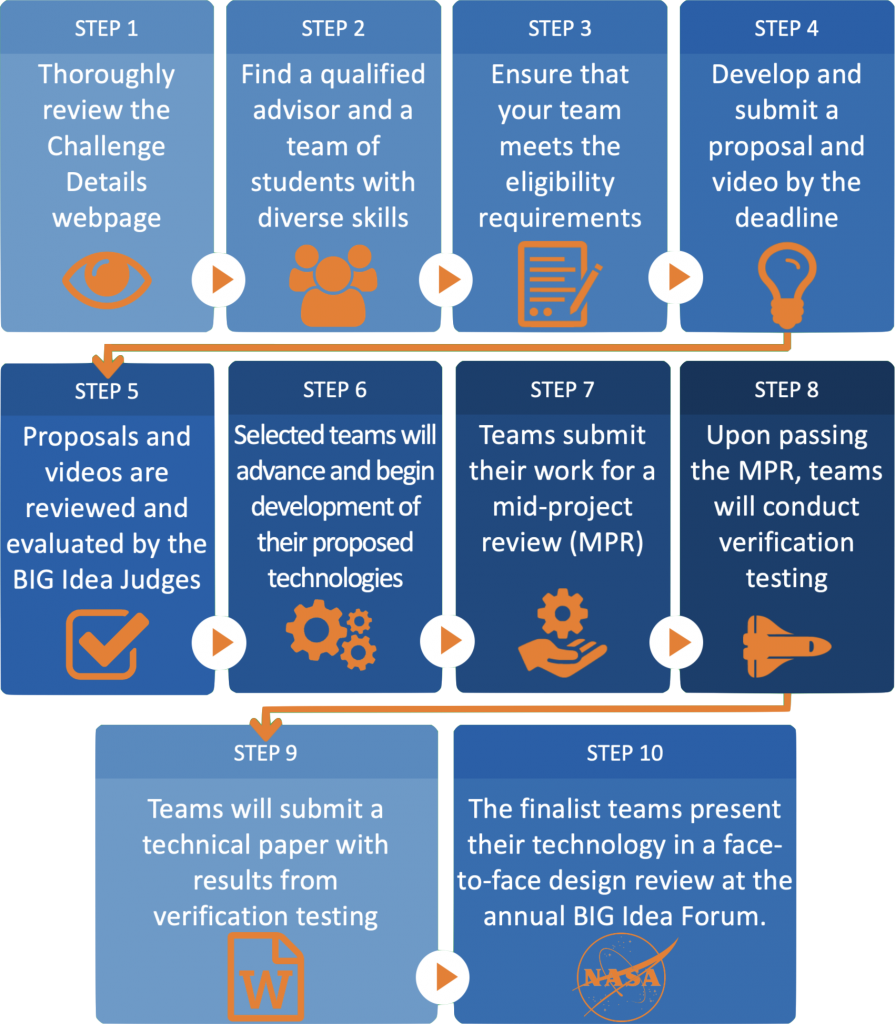
The BIG Idea Challenge is open to teams of undergraduate and graduate students at accredited U.S.-based colleges and universities officially affiliated with their state’s Space Grant Consortium. Non-Space Grant affiliated colleges/universities may partner with a Space Grant affiliated academic institution who takes a primary role on the project (i.e., the Space-Grant affiliated university must submit the proposal on behalf of the joint team). Minority Serving Institutions are encouraged to apply.
INDUSTRY PARTNERSHIPS ENCOURAGED
Teams are encouraged to collaborate and work in concert with other government or industry partners. An “industry partner” is defined as a non-government business or organization that can provide support to the team in terms of mentorship, access to labs or other facilities, in-kind donations, and/or even financial sponsorship.
Note: if a team is paying for a service provided by a specific company (e.g., paying to use a vacuum chamber for testing), the company would be considered a vendor, NOT a partner.
TEAM COMPOSITION AND SIZE LIMIT
Team sizes vary widely, but must contain, at a minimum, one U.S. citizen or legal permanent resident faculty advisor from a U.S.-based, Space Grant Affiliated university, and 5 U.S. citizen or legal permanent resident students from that university who work on the project and present at the BIG Idea Forum, each of whom must be U.S. citizens or legal permanent residents. Teams may include senior capstone students, clubs, multi-university teams, or multi-disciplinary teams.
- Team size is limited to a maximum of 25 student team members.
- Teams will be comprised of a minimum number of 5 U.S. citizen or legal permanent resident students.
- Special notes regarding foreign nationals:
- Up to 5 participating team members may be foreign nationals if they are attending the U.S.-based university submitting a proposal.
- BIG Idea Challenge funding cannot be used to directly support travel, salary, or stipends for foreign nationals.
- Due to prohibitive restrictions and ever-changing NASA security regulations, foreign nationals will not be able to attend the BIG Idea Forum if it is held on-site at a NASA Center. There will be no exceptions to this policy.
- Special notes regarding foreign nationals:
- A faculty advisor is required to attend the Forum with each team, and is a condition for acceptance into the competition
- Teams who do not have a faculty advisor present at the BIG Idea Forum will be disqualified from competing and funding will be subject to return.
- An individual (either students or faculty advisors) may join more than one team.
- A university may submit more than one proposal (multiple proposals may be funded from the same institution).
FOREIGN UNIVERSITIES - INELIGIBLE
Because this is a NASA-sponsored competition, eligibility is limited to universities in the United States. Foreign universities are not eligible to participate in the BIG Idea Challenge.
A variety of award sizes is expected (up to $180,000 max), depending on the scope of the work proposed. Proposers are encouraged to request what is actually needed to conduct the proposed work.
Special notes concerning budget:
- The expected number of new awards is somewhat uncertain, as it may depend on the distribution of submissions of sufficient highly rated proposals.
- NASA may support an award as outlined in the proposal budget, or may offer to fund only selected tasks.
- NASA has the authority to suspend or terminate an award in whole or in part, and funding is contingent upon availability.
- BIG Idea funding may not be used to directly support travel or stipends for federal employees acting within the scope of employment (this includes co-op students with civil servant status).
- BIG Idea Challenge funding may not be used to directly support travel, salary, or stipends for foreign nationals.
2-PHASED FUNDING STRUCTURE: SEPARATE INSTALLMENTS FROM TWO SOURCES
- STMD Funds for Phase 1: The 1st installment will be sent immediately upon selection so that finalist teams may begin development of their proposed concept, and will amount to 46% of the total budget requested.
- These funds will be provided directly to the lead university, from the National Institute of Aerospace (on behalf of NASA’s Space Technology Mission Directorate’s GCD Program).
- Space Grant Funds for Phase 2: The 2nd installment (i.e., the remaining portion of the total requested funds) will be provided after teams successfully complete their mid-project review in June.
- These funds will be provided directly to the state Space Grant Consortium affiliated with the primary proposing institution from NASA’s Office of STEM Engagement (National Space Grant Program), via an augmentation to the state Space Grant’s base award. The state Space Grant Consortium’s lead institution will then direct the funds to the lead university for the BIG Idea Challenge via a subaward.
BIG Idea Challenge funding is to be used for full participation in the competition, including the purchase of hardware/software, creation of analog testing environment, stipends for student research that directly supports the proposed activity, travel to the culminating design review (aka, 2022 BIG Idea Forum), etc. Please refer to the Budget portion of the Proposal section below for specific guidelines related to the intended use of funds for each installment/phase.
The judges’ panel is comprised of NASA and industry experts who will evaluate and score all the competition deliverables, including the proposal submissions. Submissions will be evaluated and judged based on adherence to the guidelines and constraints, as well as the evaluation criteria below:
- Technical Innovation (Max - 30 points)
- How innovative is the proposed solution?
- How well does the proposed technology advance the state of the art?
- How compelling is the proposed concept’s goals and objectives?
- How well does the proposed concept align with NASA’s lunar exploration goals and challenge guidelines? (Refer to NASA’s Plan for Sustained Lunar Exploration and Development)
- Technical Credibility (Max - 25 points)
- Does the technology help solve a real problem?
- How feasible is the proposed technology?
- Is credibility of the proposed solution presented?
- Is the TRL advancement plan of the proposed technology viable?
- What level of risk is associated with development and verification of the concept?
- What is the risk mitigation plan?
- Has the team proposed a rigorous systems engineering approach?
- Is the technology operationally resilient? (i.e., the ability to withstand adverse circumstances and the harsh lunar environment; the capability to degrade gracefully)
- Technical Management (Max - 20 points)
- Is the cost plan, including cost feasibility, value, and risk adequate, thorough, and reasonable?
- Is the proposed implementation plan adequate and thorough?
- What is the probability of team success? [i.e., team expertise (including faculty and any industry support), access to required facilities, etc.]
- Performance Verification Testing (Max - 25 points)
- How feasible is the verification and validation testing for the proposed technology?
- Is the team’s proposed verification testing thorough?
- Does the testing environment adequately represent the lunar environment?
Teams selected to receive funding and attend the on-site Forum will be responsible for the following Project Deliverables:
- Mid-Project Report
- 6-9-page report demonstrating where the team is in the development of their proposed system
- Reports must provide confidence the team can complete their system by the challenge delivery dates in order to receive the 2nd half of their stipend award
- Verification Demonstration
- Finalist teams will be required to perform system verification, to include analysis, testing, and demonstrations. Results will be provided to the judges in the technical reports and presentations. Teams are encouraged to be creative in designing their own test environments in order to provide confidence their system can operate as intended. Reminder: physics-based modeling may support verification but is not a sufficient replacement for hardware testing.
- 15-25 page Technical Paper
- 25–minute Presentation/Design Review, with an additional 25 minutes of Q&A at the BIG Idea Forum
- Technical Poster (for Poster Session conducted during on-site Forum)
- Both paper and digital poster files will be required
Additional details on these deliverables will be communicated to the teams after selection for funding.
REQUIRED TEMPLATES FOR 2022 CHALLENGE FINALISTS
⇒ 2022 BIG Idea Mid-Project Review Safety Letter
⇒ 2022 BIG Idea Final Technical Paper Quad Chart
⇒ 2022 BIG Idea Final Deliverables Scoring Matrix
2022 CHALLENGE RESOURCES
More resources will be listed as they are made available.
Repositories/Multiple Resources
⇒ NASA Technical Report Server (NTRS)
⇒ MAPTIS (Materials and Processes Technical Information System)***
***To request access to MATPIS, choose "Register," complete the form being sure to note in the 'Justification' block that you are associated with NASA's BIG Idea Challenge. Your request will be reviewed by a NASA Official.***
⇒ SPOON – repository of flight certified parts and their successes
⇒ Quality control training classes: The AAQ (Academy of Aerospace Quality)
Webpages/PDFs
⇒ NASA Spacecraft Materials Guide
⇒ NASA VIPER rover and Astrobotic Griffin lander select moon landing site for 2023
⇒ NASA Cost Estimating Handbook Version 4.0
⇒ APL Lunar Simulants Assessment
⇒ Commercial Simulant Providers (Exolith Lab, Off Planet Research)
⇒ The Artemis Plan: NASA's Lunar Exploration Program Overview, September 2020
⇒ NASA Technology Readiness Level Definitions
⇒ NASA’s Plan for Sustained Lunar Exploration and Development
BIG Idea Challenge competitors may use the Challenge name, logo, and images below on anything which specifically and positively represents the Challenge. This includes any presentations you do before, during, and after the onsite portion of the challenge.
LOGO
Looking for the BIG Idea logo? Click here!
NASA Logo/Media Usage Guidelines
IMAGES
More images will be added as they are available. Click on an image to enlarge.
By submitting a proposal for the BIG Idea Challenge, the proposers acknowledge that they have read and agree to abide by the Intellectual Property and Media Release Statements.
The Breakthrough, Innovative and Game-changing (BIG) Idea Challenge is an initiative supporting NASA’s Space Technology Mission Directorate’s (STMD’s) Game Changing Development Program’s (GCD) efforts to rapidly mature innovative and high-impact capabilities and technologies for infusion in a broad array of future NASA missions.
